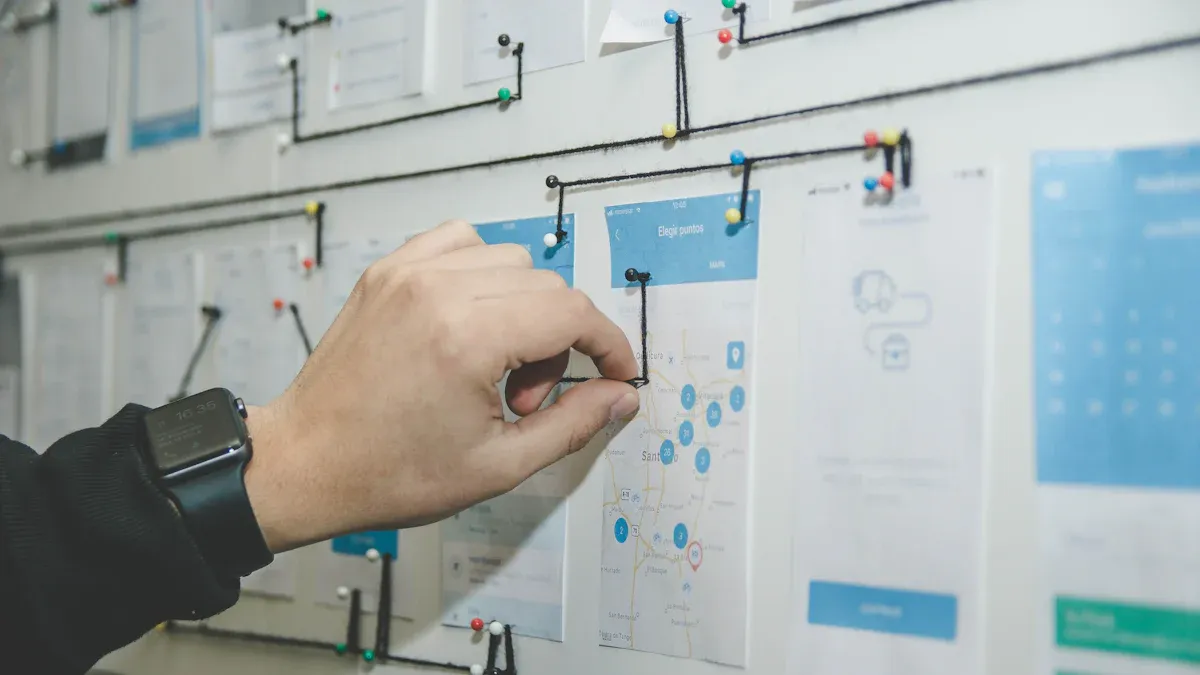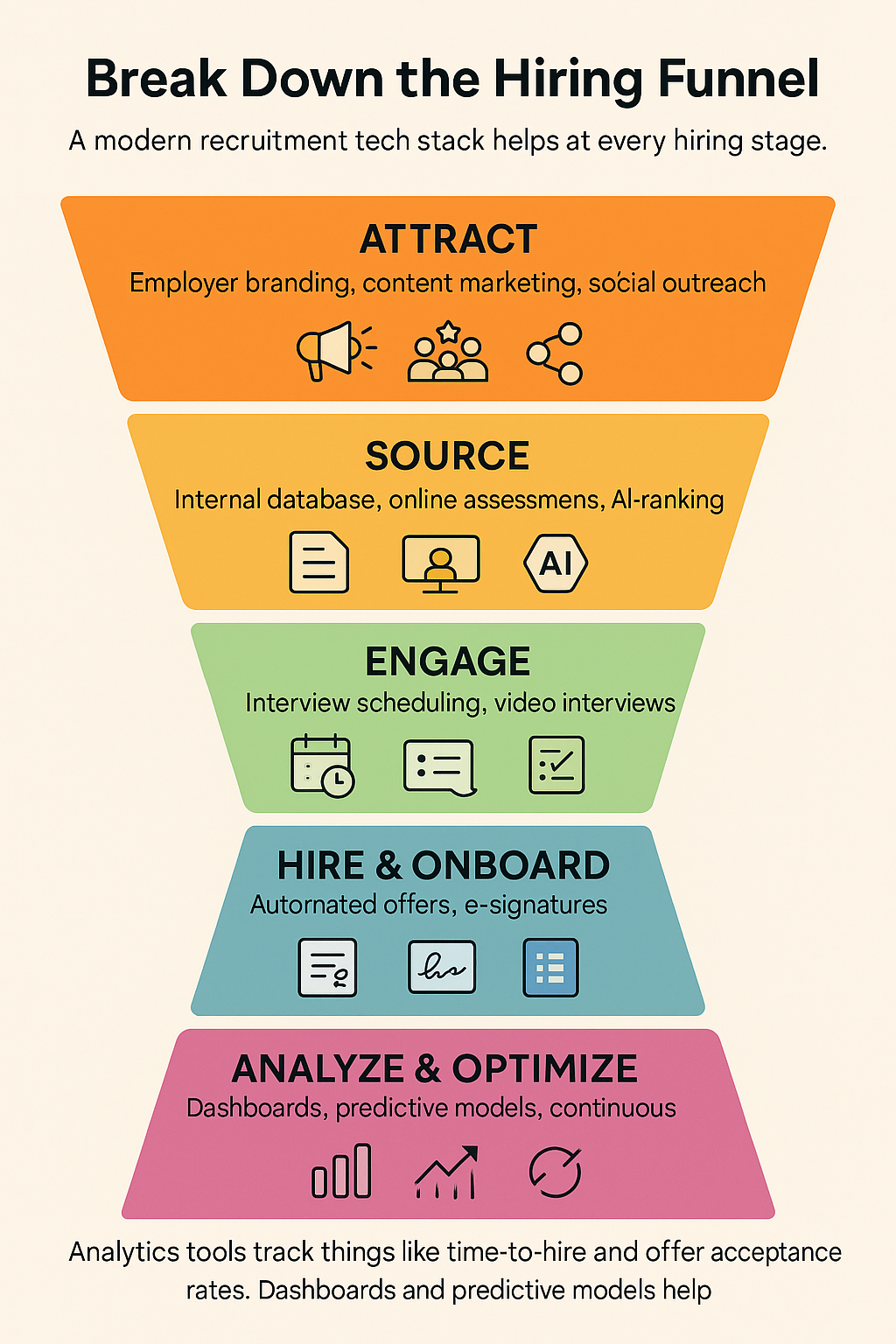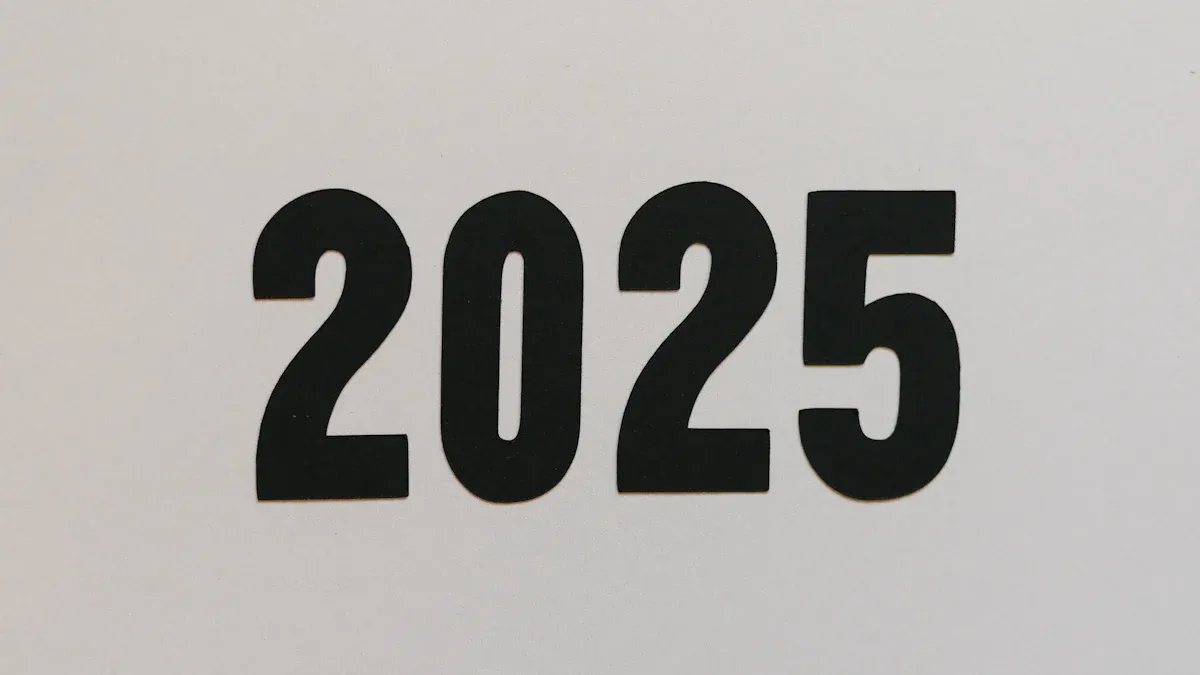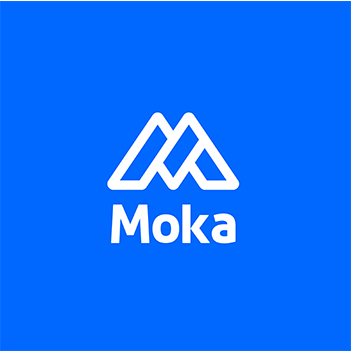What Goes in a Top-Performing 2025 Recruiting Tech Stack

The hiring world in 2025 is not like before. Companies use a recruitment tech stack to face new problems. Some trends are causing these changes:
Most new jobs are in healthcare, government, and hospitality.
Skills-first hiring is growing. Only 17.6% of jobs need a bachelor’s degree.
The workforce is getting smaller because people are aging and fewer people move here.
Wages are steady, and job ads are still higher than before the pandemic.
Organizations use a remote recruitment tech stack for flexible work. Almost 24% of new jobs are hybrid now. Fully remote jobs stay at 13%. The table below shows how remote and hybrid jobs are now normal in the U.S.
Recruiting teams have some big problems with their recruitment tech stack. They have trouble with diversity hiring. They get too many applications. It is hard to find good candidates. Many teams say their recruitment tech stack does not work well together. This causes data silos and a bad experience for candidates. Companies now spend more on their remote recruitment tech stack. They want to use technology to make every part of recruiting better.
A good recruiting tech stack helps teams hire faster. It makes the candidate experience better. It helps with compliance. With the right recruitment tech stack, companies can handle remote and hybrid work. They can manage lots of applicants. They can make better hiring choices.
Define Your Recruiting Needs
Every company has its own hiring problems. To build a strong recruitment tech stack for 2025, teams must know what they need. This step helps companies pick the right recruitment technology. It also makes sure the tech stack helps with talent acquisition goals now and later.
Map Your Scenarios
Recruiting teams work in many places. Each situation changes the recruitment tech stack and tools needed.
High-volume hiring vs. critical roles
Some companies need to hire many people fast, like in retail or hospitality. Others need to fill a few important jobs that need special skills. High-volume hiring uses automation and bulk communication tools. Critical roles need advanced sourcing, targeted outreach, and deeper candidate assessments.
Use job boards to post jobs and reach more people.
Use social media like LinkedIn to find passive candidates and show off employer branding.
Work with recruitment agencies to find special talent or hire faster.
Centralized recruitment team vs. distributed HRBPs
A centralized recruitment team does all hiring from one place. This helps make the process the same and use a connected tech stack. Distributed HR business partners (HRBPs) hire in different places or departments. They need flexible recruitment technology for teamwork and sharing data fast.
Industry requirements: tech, compliance, campus programs
Different industries have special needs. Tech companies may use skills assessments and coding tests. Sectors like healthcare or finance need strict compliance and safe data management. Campus programs need tools for events, internships, and early talent pipelines. The remote recruitment tech stack must fit these industry needs.
Break Down the Hiring Funnel
A modern recruitment tech stack helps at every hiring stage. Each stage narrows down talent and shapes the technology needed for a good candidate experience.
Attract: Employer branding, content marketing, social outreach
Companies get noticed by showing their brand and culture. Recruitment marketing tools help make fun job ads and social media posts. These tools reach both active and passive talent.
Source: Internal database, external job boards, social sourcing
Sourcing tools help recruiters find talent in many places. Internal databases keep old applicants. External job boards and social platforms help search wider. A connected tech stack lets teams track and manage all sources together.
Screen: Resume parsing, online assessments, AI-ranking
Screening tools use AI to check resumes and rank candidates. Online assessments test skills and knowledge. These tools save time and help recruiters focus on the best talent.
Engage: Interview scheduling, video interviews, structured scorecards
Engagement tools make it easy to set up interviews and get feedback. Video interview platforms let people interview from anywhere. Structured scorecards help make fair and equal choices.
Hire & Onboard: Automated offers, e-signatures, onboarding workflows
When a company picks a candidate, the recruitment tech stack sends offer letters and e-signatures automatically. Onboarding tools help new hires with paperwork and training. This smooth process makes the candidate experience better and helps new talent start strong.
Analyze & Optimize: Dashboards, predictive models, continuous improvement
Analytics tools track things like time-to-hire and offer acceptance rates. Dashboards and predictive models help teams see trends and improve hiring. Continuous improvement keeps the recruitment tech stack working well as needs change.

Core Components of a Modern Recruitment Tech Stack
A top recruitment tech stack in 2025 has several main parts:
Applicant Tracking System (ATS): Keeps candidate data in one place, manages pipelines, and helps with compliance.
Candidate Relationship Management (CRM): Keeps in touch with passive talent and past applicants.
Sourcing Tools: Help find more people through job boards, social media, and talent communities.
Assessment Platforms: Give online tests and structured interviews for fair checks.
Interview Scheduling and Video Tools: Make it easy to set up interviews and do them remotely.
Onboarding Solutions: Automate paperwork and training for new hires.
Analytics and Reporting: Give real-time dashboards and predictions for better choices.
Companies using an all-in-one platform, like Moka HR, get a big advantage. Moka HR puts sourcing, screening, engagement, automation, analytics, and scheduling in one place. This stops teams from using too many separate tools. For example, companies using Moka HR have cut hiring time by over 50% and made recruiters twice as efficient. Automated onboarding and connected data also lower candidate renege rates and help keep employees longer.
The Value of Unified Solutions
A unified recruitment tech stack means fewer tools and better efficiency. When all tools connect in real time, recruiters avoid data silos and mistakes from typing things twice. Unified dashboards let teams manage thousands of job boards and candidate sources from one spot. Automation and AI make boring tasks easier, so recruiters can focus on important talent work. Research shows that integrated recruitment technology can make teams 30% more efficient, improve retention by 60%, and save money by hiring faster.
Maximize Recruiter Productivity
Recruiters in 2025 have more work than before. Teams use automation, AI, and connected tools to help them. These tools let recruiters spend time on important tasks, not just busywork.
Workflow Automation
Workflow automation changes how recruiters do their jobs. Automated systems send emails, texts, and surveys. They also update records for recruiters. This saves each recruiter about 3.2 hours every day. Companies save around $90,000 per recruiter each year by automating scheduling and screening. Recruiters can send over 16,000 messages and updates each year. This gives them 763 more hours to do other things. With this extra time, teams can fill more jobs without hiring more people. Automation also makes candidates happier. It cuts down wait times and makes everything smoother.
Recruiter productivity goes up by 10-50%.
AI screening lowers the cost per hire by 30%.
Recruiters spend less time on boring tasks and more time talking to people.
Integrated Scheduling
Integrated scheduling tools make planning interviews easy. These tools connect to calendars. Candidates can pick their own interview times. Recruiters spend 70% less time on admin work with these tools. For example, Bardwood used AI scheduling and cut hiring time in half. Features like load balancing, smart slot picks, and mobile-friendly design help recruiters avoid mistakes and feel less tired.
Feature | Benefit |
|---|---|
Load balancing | Stops interviewers from getting too tired |
Smart slot suggestions | Picks the best times for everyone |
Candidate empowerment | Lets candidates choose their own times |
Email reminders | Helps people remember their interviews |
These features help recruiters work faster and give candidates a better experience.
Interview Intelligence
Interview intelligence platforms use AI to help with interviews. They record talks and give feedback right away. These tools help recruiters make fair and quick choices. Automatic transcripts and set interview guides make sure everyone gets the same questions. Data and analytics show patterns and help teams get better.
Interview intelligence helps companies:
Lower turnover by 67%
Improve first-year performance by 70%
Raise quality of hire by 68%
Save recruiters 74% of their time
Using these tools helps recruiters do more and make better hiring decisions.
Core Tech Stack Components

Applicant Tracking System (ATS)
Centralized resume database, pipeline visualization, audit logs
A good recruitment tech stack starts with an applicant tracking system. This tool keeps all candidate information in one place. Recruiters can look up, sort, and organize resumes fast. Pipeline visualization lets teams see each candidate’s progress. Audit logs record every step, so it is easy to check actions and stay on track.
Eliminates manual handoffs, enforces compliance, gives visibility
Applicant tracking systems stop the need for typing data by hand. They link with onboarding and HR systems, so info moves easily. This helps teams follow rules like GDPR and PDPA. Recruiters can see every part of the hiring process.
Selection criteria: UX, API integrations, GDPR/PDPA compliance
When picking an ATS, teams want a simple design, strong API links, and privacy law support. The best systems have resume parsing, job posting, messaging, and analytics. They also help lower bias and make things better for candidates.
Implementation
To set up an ATS, connect it to other recruitment tools. Train recruiters to use automation and ai features. Make sure the system keeps data safe and supports e-signatures. Check the setup often to keep things smooth and follow the rules.
CRM / Talent Pool Management
Nurture passive candidates, maintain relationships
CRM tools help recruiters stay in touch with people not ready to apply. These systems track skills, interests, and past talks. Recruiters can send updates and job alerts to keep candidates interested.
Re-engage past applicants, reduce cost-per-hire
With CRM, teams can reach out to people who applied before. This saves money and fills jobs faster. Outbound candidates often get hired quicker than inbound ones.
Tagging: Skills, interests, interaction history
Recruiters use tags to sort talent by skills and interests. This makes it easy to find the right person for each job.
Automated campaigns: Email, SMS drip sequences
Automated campaigns help keep candidates engaged. AI tools send custom messages by email and SMS. These campaigns get more replies and help recruiters handle more people at once.
Sourcing & Engagement Tools
Browser plugins, social recruiting platforms, talent communities
Recruiters use browser plugins and social sites to find talent. These tools help teams reach more people and connect with passive candidates.
Expand candidate sources faster, improve outreach
Recruitment technology grows the pool of candidates. Programmatic ads and social media reach many groups. This helps hiring outcomes and supports diversity.
Deploy LinkedIn Recruiter, GitHub search extensions
Teams use LinkedIn Recruiter and GitHub tools to find skilled people. These platforms help spot people with the right experience.
Run targeted social media ads with chatbots for pre-screening
AI chatbots handle first talks with candidates. They answer questions and collect info, making things faster and more personal.
Assessment & Interview Automation
Online assessments, video-interview platforms, standardized scorecards
Assessment tools let recruiters test skills online. Video interviews and scorecards make things fair and the same for everyone.
Objective evaluation, consistent hiring process
Automation cuts down bias and helps teams use data to decide. Standard tests and interview guides give every candidate the same chance.
Build skill & behavioral test banks
Recruiters make test banks for different jobs. They use real examples and set questions to check skills and behaviors.
Create interview templates and train hiring managers
Templates and training help hiring managers do better interviews. This leads to better hires and a smoother process.
Analytics & AI Insights
Real-time dashboards, predictive analytics, churn risk models
Analytics tools show real-time hiring data. Predictive models help teams see trends and plan for what’s next.
Data-driven decisions, measurable ROI, process transparency
AI tools turn data into helpful insights. Recruiters can measure time-to-fill, offer acceptance, and candidate happiness. These numbers show what works and what needs fixing.
Define KPIs: Time-to-Fill, Offer Acceptance Rate, Candidate NPS, Diversity metrics
Teams track key numbers to see how they are doing. These include time-to-hire, cost-per-hire, and diversity.
Set up BI dashboards and schedule regular reviews
Business intelligence dashboards keep data neat. Regular reviews help teams change their tech stack for better results.
Tip: Connect all tools in the recruitment tech stack for smooth data flow. Train teams on new ai powered recruitment tools. Always check for compliance and security.
Future-Proofing the Recruiting Tech Stack

Embracing AI Trends
AI is changing how companies hire people. Many companies use AI to find and check candidates faster. Machine learning helps match people’s skills to job needs. This makes hiring better. AI chatbots and virtual helpers answer questions quickly. They also give updates to candidates. This makes the hiring process easier for everyone. Recruiters save time because automation does boring tasks. Now, recruiters can spend more time talking to candidates. More companies use AI in HR every year. The market for these tools is growing fast. To use AI well, teams should watch for bias. They need to check how well the tools work. Teams should keep making their systems better. Working with AI experts helps companies avoid problems and get good results.
AI-driven sourcing helps find more candidates.
Machine learning matches people to jobs better.
Chatbots make talking to candidates more personal.
Automation lets recruiters do more important work.
Predictive analytics help guess who will get hired.
Supporting Remote and Skills-Based Hiring
Remote recruitment tech stack tools help companies find more people. Video interviews let recruiters talk to anyone, anywhere. Skills-based hiring is now very popular. Companies like IBM look at what people can do, not just their degrees. Many HR workers think skills-based hiring is the future. Skills tests and data help find the best people. These tools also make hiring fairer and more open to everyone. Skills-based hiring helps workers learn new things and move to new jobs. Some companies use talent modules to show workers how to grow. This way, teams can change and stay ready for anything.
Video interviews help reach 60% more candidates.
Skills tests make hiring 36% better.
Automated resume checks look at skills, not just school.
Skills-based hiring and upskilling help people move up.
Scalability and Adaptability
A scalable recruitment tech stack grows with the company. Teams start with a good applicant tracking system. They add digital onboarding and virtual interviews to hire faster. AI-powered tools send messages and do tasks automatically. This saves time for recruiters. Connecting all systems keeps data moving smoothly. Automation does boring work, so recruiters can focus on learning new skills. Mobile-first design is important because most people use phones to look for jobs. Good companies check their tech stack often. They focus on the main tools, measure how things are going, and keep learning. Recruiters learn new skills and work with partners to stay ahead.
Strategy | Benefit |
|---|---|
Digital onboarding | Faster, paperless hiring |
Virtual interviews | Quick, remote candidate access |
AI-powered communication | Personalized, automated outreach |
Mobile-first design | Better candidate experience |
Regular tech reviews | Stay adaptable and efficient |
A top-performing 2025 recruiting tech stack puts ATS, CRM, sourcing, assessment, and analytics tools together in one place. AI-driven solutions do tasks automatically, help match candidates, and show real-time insights. This helps recruiters work smarter and make better hires. When teams use connected workflows, they get more replies and build stronger pipelines.
FAQ
What is a recruiting tech stack?
A recruiting tech stack is a group of digital tools that help companies find, talk to, and hire new employees. These tools work together to make hiring faster and easier.
Why do companies use all-in-one platforms like Moka HR?
All-in-one platforms like Moka HR combine many hiring tools in one place. This helps recruiters save time, avoid mistakes, and keep all information organized.
How does AI help in recruiting?
AI can quickly read resumes, match people to jobs, and schedule interviews. It helps recruiters find the best candidates and makes the hiring process smoother.
What should companies check before choosing new recruiting tools?
Companies should look for tools that are easy to use, safe for data, and work well with other systems. They should also check if the tools follow privacy laws.
See Also
Building Strong Teams Using Applicant Tracking Technology
How AI Recruiting Tools Enhance Smooth Interview Experiences
Unlocking Hiring Success Through MokaHR Automation Solutions
Top Ten Applicant Tracking System Features Every Recruiter Needs
Overcoming Five Major Recruitment Automation Challenges Effectively
From recruiting candidates to onboarding new team members, MokaHR gives your company everything you need to be great at hiring.
Subscribe for more information

